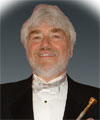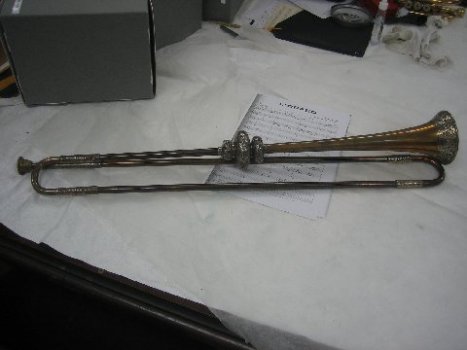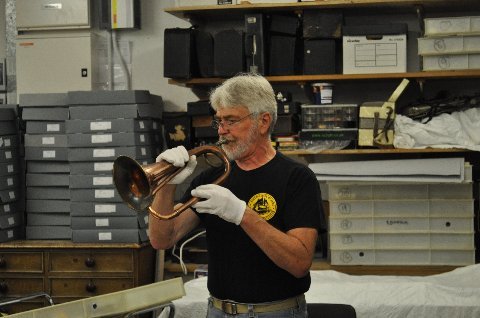Inside the Arc
“The Hunt for Bugle Genesis”
 A few days ago, I held in my hands a valveless trumpet upon which ringing fanfares were once sounded in the Royal Court of His Majesty, James II of England. This rarest of horns may also have served to enliven Shakespearian dramas and comedies of the period.
A few days ago, I held in my hands a valveless trumpet upon which ringing fanfares were once sounded in the Royal Court of His Majesty, James II of England. This rarest of horns may also have served to enliven Shakespearian dramas and comedies of the period.
Crafted of copper and brass in London by Simon Beale in 1667, it’s beautifully ornate and covered with engravings on the disc seal and bell garland. It’s a long and graceful herald, as befits an instrument made for announcing the comings and goings of royalty, single wrapped in the key of D. I raised it, closed my eyes and played. It sang out.
“Well, there you are”, said Andy Lamb, curator of the exclusive Bate Collection of Musical Instruments at Oxford. “Not exactly one of those dandy little 3-valve things like your bugle bands from Wyoming play, is it?” I explained that, in actual fact, there was a rather dandy group from Allentown who start their current show with a dozen or so similar (though not quite so vintage) instruments. I believe he was pleased that American drum corps, for all their innovations, are still directly connected to their history, even if they don’t always know it.

Photo by Frank Dorritie, Bate Collection, Oxford
One of history’s mysteries has always been the rather vague demarcation line between the bugle and the trumpet. Part of that answer was to be found here, with Andy at the Bate, and a couple of blocks away at Oxford’s great Bodleian Library, and at the incredible Ashmolean Museum a few hundred yards further on.
It’s common knowledge that the first “trumpets” to be played ceremonially in ancient cultures were conch shells and the hollowed-out horns of animals. Relics of these have been found on every continent except the Antarctic. Over time, humans began to shape their own from metal. There’s a Celtic Bronze Age bugle in the Ashmolean.
The Egyptians, Greeks, Romans and everybody else eventually got into the act, and that act, at least initially, was always ceremonial or utilitarian. Horns are loud. They declaim, proclaim, announce and signal important events. They’re still used in that way, but also have managed a more refined and polite role, an artistic one, if you will. That’s part of the answer, but it goes much deeper than that.
Even as a young Cub Scout with a gleaming “Regulation” G horn, I had sensed some vague class distinction between this blue collar device and its more sophisticated relative, the trumpet, a “real” instrument. What I didn’t know was that there was a historical precedent for that attitude that reached back almost a thousand years.
We Bugle Corps kids developed a kind of reverse snobbism to counter this. Our instrument was harder to play. We didn’t require all those superfluous valves. We played higher and louder. We never sat down and rarely stood still.
We had to overcome obstacles, exert strenuous effort and skill to tame this musical beast. No refined, polite and sissified valve instruments for us. There was no need for these crutches. We were “men”. (In truth, there was no scarcity of extraordinary female buglers on the scene, but they were the rare exceptions then, or so we thought.)
Our attitude was further supported by the relative scarcity of impressive high school band brass sections, especially in the urban centers where corps flourished. But as it happens, there has always been a difference in kind between trumpeters and buglers and one must go back to Medieval times to discover why.
Historically, the trumpet has been linked to the cavalry. This had always puzzled me. In those John Wayne movies, clearly that trooper riding at a full gallop was sounding the charge on a bugle. (Of course, that in itself was a bit of a Hollywood exaggeration. Though real cavalry calls were sometimes played on the move, it was necessarily “high in the stirrups”, and never done while hurtling down a steep 45-degree ravine at full speed, arrows and/or bullets whizzing by. In the movies, such a bugler was pitch-perfect and never chipped a single note. Talk about “suspension of disbelief”!)
And then there were all those prints, paintings and tapestries depicting squires playing long “trumpets” in Medieval tableaux, many of them riding horses or even elephants! Here’s the scoop, at least a good dollop of it:
Trumpets were traditionally the instruments of royalty, and since that was the noble class that produced knights, naturally they were used to signal those armored riders in battle, or at least to announce their presence. The foot soldier came from another stratus of society, the farmer/hunter/woodsman. Accounts of the battle of Crecy in 1346 during the Hundred Year’s War have a bearing on this trumpet/bugle thing.
The French cavalry (cue the trumpets) had been all but invincible, knights and horses alike heavily armored and disciplined in formation. The English infantry, however, now sported a new technology, the longbow, capable of two or three times the range of the French crossbow, and able to penetrate light armor.
These troops employed a different, more rustic signaling instrument, derived from the conical hunting horn, quite familiar to men accustomed to that activity’s formations. This little horn has been known by many names, one of which is “bugle”, probably derived from the German “flugel”, which actually means “wing”. How does that follow? (You may ask.) The answer lies in the way a Medieval hunt was conducted.
Picture an extended company front moving through the forest, flushing out the unfortunate creature who soon would become dinner. On the slightly curved in “wings” of the formation, “flugel men” would be stationed with their horns to signal any sightings of the prey. Particular calls signified appropriate movements. All of this was quite useful for hunting and (naturally) for moving troops in battle.
On that afternoon in the 14th Century, the English employed their longbows, infantry and fluglers to advantage, decimating the French knights (and presumably their trumpeters) in the process, establishing that lower class instrument as the new prime mover of armies.
The rest, as they say, is history, from which you are free to draw your own conclusions. One curious observation strikes me: Historically, trumpeters were associated with the more privileged classes in society. They were usually well educated and thoroughly familiar with musical notation, not unlike today’s school band players.

The author, playing a C bugle with Bb crook, made in 1800 in London.
Photo by Andy Lamb, Curator, Bate Collection, Oxford
Buglers, on the other hand, were mostly drawn from the working population and often learned their music by ear and rote. The parallels to neighborhood corps members from “back in the day” are fairly obvious.
It’s not that these latter players never moved on to the more refined brass instruments. Louis Armstrong, Philip Farkas, Clark Terry, Maynard Ferguson, Jeff Keivit, Jim D’Amico, Donald Angelica and Al Chez are well-known examples. It was fairly uncommon, however, to migrate in the other direction. My mentor (and first trumpet teacher), Buglers Hall of Famer Frank Diliberto, is one who did so quite successfully in the ?60s. Today he is a featured soloist with the Sunrisers Reunion Ensemble, Blessed Sacrament Golden Knights and Selden Cadets.
Considering the foregoing, one could be forgiven for viewing the use of trumpets in today’s Drum Corps as just a bit elitist. Bugles are clearly much more egalitarian and, given their etymology, playing them would appear downright heroic.
Come to think of it, that’s always been the case.
Frank Dorritie is one of the legends of the activity .... a performer, instructor, arranger, adjudicator, and observer over the past 5 decades. Frank has been playing the bugle and trumpet since the 1960s, and has performed with artists like Billy Cobham and Maynard Ferguson. He has instructed and/or arranged for the Blue Devils, Cadets, Santa Clara Vanguard, Cavaliers, Chesterton and Tenri High Schools, the Bushwackers, Bridgemen and a host of others. His audio production honors include 9 Grammy Nominations, 2 Grammy Awards and membership in both the World Drum Corps and Buglers Halls of Fame. He is active internationally as a clinician and adjudicator, holds the DCA Soprano/Trumpet/Tenor Individual titles for 2003, 2005 and 2006. Frank also chairs the Department of Recording Arts at Los Medanos College. His popular brass method book, “Power and Endurance”, is available from Xtremebrass.com. The opinions expressed in this column are strictly those of the author.
Posted by Frank Dorritie on Wednesday, August 11th, 2010. Filed under Inside the Arc.
